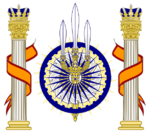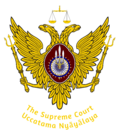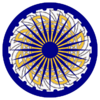User:Geordinia/sandbox4: Difference between revisions
No edit summary |
mNo edit summary |
||
| Line 50: | Line 50: | ||
Two trishulas (tridents) act as supporters; representing the royal authority of the monarch, as trishulas are a common sign of leadership and authority in Rajyaghar, as well as a further representation of the protective role of the Monarch over the realm and to represent their status as Commander-in-Chief of the armed forces. The shield features the insignia and chain of the Order of the Gryphon, the highest chivalric order in the Kingdom of Rajyaghar. The coronet above the shield is a heraldic depiction of the Rajyani Royal Crown worn by Monarchs on state occasions. | Two trishulas (tridents) act as supporters; representing the royal authority of the monarch, as trishulas are a common sign of leadership and authority in Rajyaghar, as well as a further representation of the protective role of the Monarch over the realm and to represent their status as Commander-in-Chief of the armed forces. The shield features the insignia and chain of the Order of the Gryphon, the highest chivalric order in the Kingdom of Rajyaghar. The coronet above the shield is a heraldic depiction of the Rajyani Royal Crown worn by Monarchs on state occasions. | ||
The royal coat of arms is reserved exclusively for use by the Monarch, the royal family, the Shahee Rakshak (Royal Guards) and the Mantriparishad (Royal Court) according to royal decree. The arms have faced criticism by both republicans and hardliners who believe that it is too heavily influenced by [[Euclea|euclean]] {{wp|heraldry}} and too distinct from native prateeks used across Rajyaghar. | The royal coat of arms is reserved exclusively for use by the Monarch, the royal family, the Shahee Rakshak (Royal Guards) and the Mantriparishad (Royal Court) according to royal decree. The arms have faced criticism by both republicans and hardliners who believe that it is too heavily influenced by [[Euclea|euclean]] {{wp|heraldry}} and too distinct from the designs of native prateeks used across Rajyaghar. | ||
===Versions and Variants=== | ===Versions and Variants=== | ||
| Line 90: | Line 90: | ||
==State Emblem== | ==State Emblem== | ||
The State Emblem is a variant of the National Emblem and is used by government institutions throughout the Kingdom. The various institutions, such as the Federal ([[Central Union Government]] and [[Cabinet of Rajyaghar|Ashta Pradhan]]), Judicial ([[Judiciary of Rajyaghar|Supreme Court]]) and [[Administrative divisions of Rajyaghar|State-level Governments]], all use further variations of the State Emblem. | The State Emblem is a variant of the National Emblem and is used by government institutions throughout the Kingdom. The State Emblem comprises the Charsidhan Chakra superimposed upon a Trishula, representing royal authority supporting and maintaining the state. The various institutions, such as the Federal ([[Central Union Government]] and [[Cabinet of Rajyaghar|Ashta Pradhan]]), Judicial ([[Judiciary of Rajyaghar|Supreme Court]]) and [[Administrative divisions of Rajyaghar|State-level Governments]], all use further variations of the State Emblem. | ||
The Federal Government and its agencies use a version in which the State Emblem is flanked by two pillars, draped in the national flag and topped by the heraldic version of the Rajyani Royal Crown. The Governments of Union States, known as State Governments, uses a version in which the State Emblem is encompassed within a seal with the wording of the seal being: ''Union State Government of [State]''. The seal also bears the coronet of the Rajyani Royal Crown. | The Federal Government and its agencies use a version in which the State Emblem is flanked by two pillars, draped in the national flag and topped by the heraldic version of the Rajyani Royal Crown. The Governments of Union States, known as State Governments, uses a version in which the State Emblem is encompassed within a seal with the wording of the seal being: ''Union State Government of [State]''. The seal also bears the coronet of the Rajyani Royal Crown. | ||
The Judiciary of Rajyaghar uses a version in which the State Emblem is placed upon a maroon shield held by a two-headed eagle, called Nyaykavak (Bearer of Justice). Nyaykvavak's faces look in opposite directions, representing the idea that no one can hide from it. Nyaykavak holds two trishulas which representing the royal authority bestowed on the judiciary. A balance of scales is placed above the it's heads, representing impartiality and fairness within the judicial system. By not being in contact with any part of the emblem, the scales represent impartiality. The emblem is used by all of the judicial institutions of the country, with their names placed below the emblem | The Judiciary of Rajyaghar uses a version in which the State Emblem is placed upon a maroon shield held by a two-headed eagle, called Nyaykavak (Bearer of Justice). Nyaykvavak's faces look in opposite directions, representing the idea that no one can hide from it. Nyaykavak holds two trishulas which representing the royal authority bestowed on the judiciary. A balance of scales is placed above the it's heads, representing impartiality and fairness within the judicial system. By not being in contact with any part of the emblem, the scales represent impartiality. The emblem is used by all of the judicial institutions of the country, with their names placed below the emblem. | ||
{{multiple image | {{multiple image | ||
Revision as of 21:22, 21 June 2021
| Greater Coat of Arms of the Kingdom of Rajyaghar | |
|---|---|
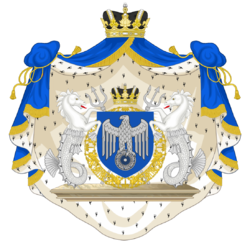 | |
| Versions | |
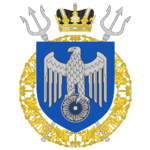 Version without the compartment and supporters | |
 Version consisting of the crowned escutcheon only | |
| Armiger | Krishan VII Maharaja of Rajyaghar |
| Adopted | 1956 |
| Crest | Royal Crown of Rajyaghar |
| Blazon | Azure, Eagle Argent holding in his sinister and dexter claws the Charsidhan Chakra Argent |
| Supporters | Two trishulas Argent and two seahorses Argent |
| Orders | Order of the Gryphon |
| Other elements | The monarch places this coat of arms on a pedastal mantle lined with Ermine. Above the mantle is a pavilion azure again topped with the royal crown. |
| Earlier versions | National Emblem of Rajyaghar Pariprateek of the Rajana Family |
The Coat of Arms of the Kingdom of Rajyaghar has greater and lesser versions.
The Royal Coat of Arms consists of a silver eagle holding the Charsidhan Chakra, in silver, all in a blue shield with the royal crown on top.
The national emblem (Charsidhan Chakra) consists of a 24-spoked wheel, representing the 24 Union States, superimposed upon the pariprateek of the Rajana Family, the royal family of Rajyaghar. The national emblem is not a variant of the Royal Coat of Arms. The state emblem of Rajyaghar is similar to the national emblem, but has a trishula as a supporter behind the Charsidhan Chakra.
The current design of the Royal Arms were introduced in 1956, under Maharaja Krishan VI. Previously, there had been no distinction between the state emblem and that used by the Monarch and royal family. Since 1956, there is a more complex royal coat of arms for the monarchy which is designated as the Royal Coat of Arms.
Royal Coat of Arms
The current version of the Royal Coat of Arms, commonly known as the Royal Arms, was established by royal decree on 21st June 1956 by Krishan VI. The Royal Arms were created in order to enable a distinction between the emblem used by government institutions, such as the federal and state governments, and the Monarchy, which had, from independence until 1956, been the State Emblem.
The shield, an azure heater, posseses a charge of an argent eagle holding in its dexter and sinister claws the charsidhan chakra in argent. The eagle represents the Monarch of Rajyaghar and its position in holding the charsidhan chakra represents the role of the monarch in their duty to protect, preserve and promote the realm and its peoples. The blue shield represents the maritime history of the Sanyukti Empire, later Naratha Confederacy and modern Rajyaghar and their status as maritime nations.
Two trishulas (tridents) act as supporters; representing the royal authority of the monarch, as trishulas are a common sign of leadership and authority in Rajyaghar, as well as a further representation of the protective role of the Monarch over the realm and to represent their status as Commander-in-Chief of the armed forces. The shield features the insignia and chain of the Order of the Gryphon, the highest chivalric order in the Kingdom of Rajyaghar. The coronet above the shield is a heraldic depiction of the Rajyani Royal Crown worn by Monarchs on state occasions.
The royal coat of arms is reserved exclusively for use by the Monarch, the royal family, the Shahee Rakshak (Royal Guards) and the Mantriparishad (Royal Court) according to royal decree. The arms have faced criticism by both republicans and hardliners who believe that it is too heavily influenced by euclean heraldry and too distinct from the designs of native prateeks used across Rajyaghar.
Versions and Variants
Royal Family
Additional usage
| National Emblem Charsidhan Chakra | |
|---|---|
 | |
| Versions | |
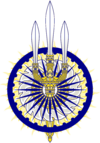 State Emblem, consisting of the National Emblem and trishula supporter | |
| Armiger | Maharaja of Rajyaghar Central Union Government State Governments Judiciary of Rajyaghar |
| Adopted | 1946 |
| Blazon | Charsidhan Chakra |
| Supporter | Trishula |
| Other elements | Various elements included on variations of the state version |
National Emblem
The National Emblem of Rajyaghar, also known as the Charsidhan Chakra, is the official civil emblem (prateek) of the Kingdom of Rajyaghar.
The state emblem consists of the Charsidhan Chakra with a trishula placed through the chakra. The state emblem has many variants which are used by the Central Union Government, Supreme Court and state governments.
The national emblem (Charsidhan Chakra) is made up of the pariprateek of the Rajana Family, the royal family of Rajyaghar, and a 24-spoked wheel which represents the unity of the 24 Union States of Rajyaghar.
State Emblem
The State Emblem is a variant of the National Emblem and is used by government institutions throughout the Kingdom. The State Emblem comprises the Charsidhan Chakra superimposed upon a Trishula, representing royal authority supporting and maintaining the state. The various institutions, such as the Federal (Central Union Government and Ashta Pradhan), Judicial (Supreme Court) and State-level Governments, all use further variations of the State Emblem.
The Federal Government and its agencies use a version in which the State Emblem is flanked by two pillars, draped in the national flag and topped by the heraldic version of the Rajyani Royal Crown. The Governments of Union States, known as State Governments, uses a version in which the State Emblem is encompassed within a seal with the wording of the seal being: Union State Government of [State]. The seal also bears the coronet of the Rajyani Royal Crown.
The Judiciary of Rajyaghar uses a version in which the State Emblem is placed upon a maroon shield held by a two-headed eagle, called Nyaykavak (Bearer of Justice). Nyaykvavak's faces look in opposite directions, representing the idea that no one can hide from it. Nyaykavak holds two trishulas which representing the royal authority bestowed on the judiciary. A balance of scales is placed above the it's heads, representing impartiality and fairness within the judicial system. By not being in contact with any part of the emblem, the scales represent impartiality. The emblem is used by all of the judicial institutions of the country, with their names placed below the emblem.
Regulated Usage
The usage of any version of the Coat of Arms is heavily regulated by Rajyani Law. The Emblem of Rajyaghar Act (1946), Royal Decree of 1956 and Defence of the Monarchy Act 1965 all contain clauses related to the use, display and distribution of the Royal Arms, State Emblem and National Emblem.
Any representation consisting of the charsidhan chakra and an eagle, considered to be the royal coat of arms, and its usage is restricted by law. Any representation consisting of the charsidhan chakra and a trishula, considered to be the state emblem, and its usage is also restricted by law. The National Emblem may be used for civilian purposes but this is heavily regulated by the Ministry of Constitutional Affairs.

